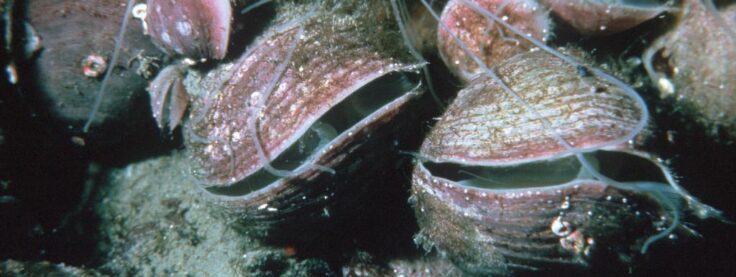Skeleton structure, size, predation and climate change
- Start date
- 1 October, 2012
How do the skeletons of marine animals change with habitat and environmental conditions?
External skeletons, in the form of calcium carbonate shells are found predominantly in molluscs and brachiopods (marine organisms that look like they should be molluscs, but are actually only distantly related). These shells provide support for the animals’ internal organs, and also protect internal tissues from the external environment, potential diseases and, on particular predators. Any change in the thickness or crystalline structure of the shell can therefore have serious consequences for the animal inside. We also look in some detail at the incremental growth patterns that are preserved in bivalves and brachiopods. How has the extreme seasonality in polar climates influenced the composition of marine communities?

Understanding how the external skeleton changes in response to environmental pressures is helping us predict how a major part of the marine ecosystem (molluscs make up 23% of all marine species) will fare under climate change. Our investigations will also focus on brachiopods as they are very diverse, found all over the globe and are very well represented in fossil records.

Hence we can use brachiopods to examine changes in shell structure not only across geographic regions, but also through time. We can then relate these findings to past climate records and ancient sea conditions. Our investigations of molluscs and brachiopods encompass samples from the tropics to both poles and thus contributes to the BAS Grand Challenges on Polar Change and Earth to the Poles.
This is a mulitdisciplinary project in which we are building up our knowledege on shell dynamics in space and time via several different projects and funding streams.
Project areas and aims include:
- Identification of the impacts of primary crushing predators on molluscs and brachiopods from the topics to the poles. We are also looking at drilling predation rates across the same geographical regions.
- Identification of predator intensity and other phenomenon incluing how growth limits (particularly large and small size) may provide a refuge from predation.
- Drilling and predation in fossil assemblages: more to add
- Evaluation of the capacity of brachiopods from the Antarctic and New Zealand to maintain thickness and integrity and repair shell damage in experimentally induced low pH conditions (Ocean acidification studies). This is the subject of a PhD thesis by Emma Cross (NERC funding reference NE/1019565/1).
- Understanding how shell thickness in the blue mussel (Mytilus edulis) varies with latitude and whether this is controlled by genetics. This is the subject of a PhD thesis by Luca Telesca (EU Marie Curie funding reference: 605051)
